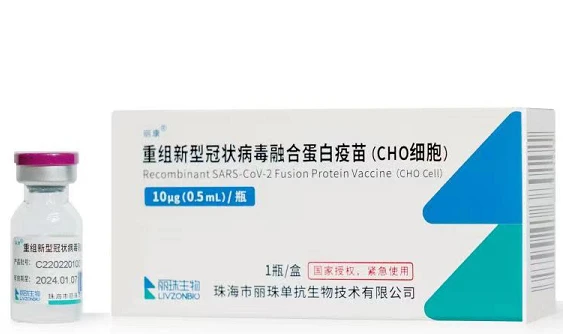预约演示
更新于:2025-08-29

Livzon Group Limin Pharmaceutical Factory
更新于:2025-08-29
概览
标签
肿瘤
神经系统疾病
消化系统疾病
中药
小分子化药
疾病领域得分
一眼洞穿机构专注的疾病领域
暂无数据
技术平台
公司药物应用最多的技术
暂无数据
靶点
公司最常开发的靶点
暂无数据
| 排名前五的药物类型 | 数量 |
|---|---|
| 小分子化药 | 1 |
| 中药 | 1 |
| 排名前五的靶点 | 数量 |
|---|---|
| UL30 x UL54 | 1 |
关联
2
项与 丽珠集团利民制药厂 相关的药物靶点- |
作用机制- |
在研机构 |
原研机构 |
最高研发阶段批准上市 |
首次获批国家/地区 中国 |
首次获批日期1999-01-01 |
3
项与 丽珠集团利民制药厂 相关的临床试验CTR20223022
黄体酮注射液与Prolutex®在绝经后健康女性受试者中的随机、开放、两周期、双交叉的生物等效性试验
比较受试制剂黄体酮注射液和参比制剂Prolutex®在绝经后健康女性受试者中单次给药的药代动力学(PK)特征,并评价受试制剂与参比制剂的生物等效性。
开始日期2022-12-05 |
申办/合作机构 |
CTR20202157
以原研药丁苯酞氯化钠注射液(恩必普)为参比制剂进行丽珠集团利民制药厂生产的丁苯酞氯化钠注射液在健康受试者中的生物等效性研究
主要研究目的:研究空腹条件下静脉滴注受试制剂丁苯酞氯化钠注射液(规格:100mL:丁苯酞25mg与氯化钠0.9g)与参比制剂丁苯酞氯化钠注射液(规格:100mL:丁苯酞25mg与氯化钠0.9g)在健康受试者体内的药代动力学,评价空腹条件下两种制剂的生物等效性。
次要研究目的:比较健康受试者静脉滴注石药集团恩必普药业有限公司生产的丁苯酞氯化钠注射液(恩必普®)和丽珠集团生产的丁苯酞氯化钠注射液后的安全性。
开始日期2020-11-04 |
申办/合作机构 |
CTR20150751
喷昔洛韦氯化钠注射液与阿昔洛韦氯化钠注射液治疗带状疱疹多中心、随机、盲法、平行对照临床试验。
喷昔洛韦氯化钠注射液治疗带状疱疹的有效性和安全性评估
开始日期- |
申办/合作机构  丽珠集团利民制药厂 丽珠集团利民制药厂 [+1] |
100 项与 丽珠集团利民制药厂 相关的临床结果
登录后查看更多信息
0 项与 丽珠集团利民制药厂 相关的专利(医药)
登录后查看更多信息
2
项与 丽珠集团利民制药厂 相关的文献(医药)2017-05-01·Journal of Zhejiang University. Science. B3区 · 生物学
Rapid quantification of multi-components in alcohol precipitation liquid of Codonopsis Radix using near infrared spectroscopy (NIRS)
3区 · 生物学
Article
作者: Huang, Wen-Hua ; Luo, Yu ; Song, Yan-Gang ; Li, Wen-Long ; Qu, Hai-Bin ; Liu, Xue-Hua
A near infrared spectroscopy (NIRS) approach was established for quality control of the alcohol precipitation liquid in the manufacture of Codonopsis Radix. By applying NIRS with multivariate analysis, it was possible to build variation into the calibration sample set, and the Plackett-Burman design, Box-Behnken design, and a concentrating-diluting method were used to obtain the sample set covered with sufficient fluctuation of process parameters and extended concentration information. NIR data were calibrated to predict the four quality indicators using partial least squares regression (PLSR). In the four calibration models, the root mean squares errors of prediction (RMSEPs) were 1.22 μg/ml, 10.5 μg/ml, 1.43 μg/ml, and 0.433% for lobetyolin, total flavonoids, pigments, and total solid contents, respectively. The results indicated that multi-components quantification of the alcohol precipitation liquid of Codonopsis Radix could be achieved with an NIRS-based method, which offers a useful tool for real-time release testing (RTRT) of intermediates in the manufacture of Codonopsis Radix.
Separations
Development and Validation of a Near-Infrared Spectroscopy Method for Multicomponent Quantification during the Second Alcohol Precipitation Process of Astragali radix
作者: Huang, Wenhua ; Luo, Yu ; Wang, Guoxiang ; Li, Wenlong ; Qu, Haibin ; Wang, Xi ; Gong, Xingchu
The objective of this study was to develop and validate a near-infrared (NIR) spectroscopy based method for in-line quantification during the second alcohol precipitation process of Astragali radix. In total, 22 calibration experiments were carefully arranged using a Box–Behnken design. Variations in the raw materials, critical process parameters, and environmental temperature were all included in the experimental design. Two independent validation sets were built for method evaluation. Validation set 1 was used for optimization. Different spectral pretreatments were compared using a “trial-and-error” approach. To reduce the calculation times, the full-factorial design was applied to determine the potential optimal combinations. Then, the best parameters for the pretreatment algorithms were compared and selected. Partial least squares (PLS) regression models were obtained with low complexity and good predictive performance. Validation set 2 was used for a thorough validation of the NIR spectroscopy method. Based on the same validation set, traditional chemometric validation and validation using accuracy profiles were conducted and compared. Conventional chemometric parameters were used to obtain the overall predictive capability of the established models; however, these parameters were insufficient for pharmaceutical regulatory requirements. Then, the method was fully validated according to the ICH Q2(R1) guideline and using the accuracy profile approach, which enabled visual and reliable representation of the future performances of the analytical method. The developed method was able to determine content ranges of 8.44–39.8% at 0.541–2.26 mg/mL, 0.118–0.502 mg/mL, 0.220–0.940 mg/mL, 0.106–0.167 mg/mL, 0.484–0.879 mg/mL, and 0.137–0.320 mg/mL for total solid, calycosin glucoside, formononetin glucoside, 9, 10-dimethoxypterocarpan glucopyranoside, 2′-dihydroxy -3′, 4′-dimethoxyisoflavan glucopyranoside, astragloside II, and astragloside IV, respectively. These ranges were specific to the early and middle stages of the second alcohol precipitation process. The method was confirmed to be capable of achieving an in-line prediction with a very acceptable accuracy. The present study demonstrates that accuracy profiles offer a potential approach for the standardization of NIR spectroscopy method validation for traditional Chinese medicines (TCMs).
6
项与 丽珠集团利民制药厂 相关的新闻(医药)2024-03-29
·米内网
精彩内容随着时间推移,近几年不断有国内药企抢仿已上市多年的重磅国产原研化药,部分原研企业加快布局改良新药、拓展新适应症来面对冲击。丁苯酞、艾普拉唑、艾拉莫德、吗啉硝唑等畅销品种已在国内上市超过10年,有的遭改良新药围攻,有的则被国内巨头抢仿。命运的齿轮已开始转动,新的格局即将到来。表1:近几年部分遭国内药企抢攻的重磅国产原研化药来源:米内网中国上市药品(MID)数据库丁苯酞:超60亿大品种,遭改良新药夹击丁苯酞是继青蒿素和双环醇之后我国第三个自主研发并获批的创新药,石药集团在2005年正式上市了丁苯酞软胶囊,随后在2010年上市了丁苯酞氯化钠注射液。丁苯酞软胶囊在2009年进入国家医保常规目录,丁苯酞氯化钠注射液则在2017年进入国家医保常规目录,随后在2020年起两个产品均转入了国家医保谈判目录。丁苯酞软胶囊限新发的急性缺血性脑卒中患者在发作72小时内开始使用,丁苯酞氯化钠注射液则限新发的急性缺血性脑卒中患者在发作48小时内开始使用。图1:近几年丁苯酞的销售情况(单位:万元)来源:米内网中国公立医疗机构药品终端竞争格局米内网数据显示,在中国城市公立医院、县级公立医院、城市社区中心及乡镇卫生院(简称中国公立医疗机构)终端,丁苯酞的整体销售额在2020-2022年保持在60亿元以上,是国产原研化药中最畅销的品种。2023年上半年在神经系统药物市场,丁苯酞成为了TOP1品种。为了进一步提升丁苯酞的竞争实力,石药集团针对胶囊剂开发新适应症。目前丁苯酞软胶囊的血管性痴呆适应症已进入III期临床,而紫杉类所致周围神经病变适应症也在II期临床阶段。2017年南京优科制药提交了丁苯酞注射液的2.2类新药临床申请,同年丽珠集团利民制药厂提交了丁苯酞氯化钠注射液的4类仿制上市申请,成为了第一批抢攻的国内企业,尽管最终等来的是“批准临床”的结果,但其先锋意义依然重大。随后,四川汇宇制药、河北仁合益康药业等5家国内药企陆续加入战局,均为丁苯酞注射液的2.2类新药。截至目前仍未有其他国内药企提交丁苯酞制剂的上市申请并在审,最终是该品种是仿制药取胜还是改良新药突围,值得继续观察。艾普拉唑:丽珠抢攻改良新药,石药仿制药搅局艾普拉唑是我国消化治疗领域的第一个创新药,丽珠集团在2007年获批了艾普拉唑肠溶片,随后在2017年获批了注射用艾普拉唑钠。艾普拉唑肠溶片在2017年进入国家医保常规目录,注射用艾普拉唑钠在2019年进入国家医保谈判目录。目前艾普拉唑肠溶片限有十二指肠溃疡、反流性食管炎诊断患者的二线用药,注射用艾普拉唑钠则限预防重症患者应激性溃疡出血以及消化性溃疡出血。图2:近几年艾普拉唑的销售情况(单位:万元)来源:米内网中国公立医疗机构药品终端竞争格局艾普拉唑自上市以来在中国公立医疗机构终端的销售额快速上涨,进入医保后增速更为明显,该品种2019年突破10亿元,2021年达到峰值35亿元。2023年上半年在治疗与胃酸分泌相关疾病的药物市场,艾普拉唑成为TOP2品种。为了牢牢抓紧这个潜力大品种,丽珠集团一方面拓展注射用艾普拉唑钠的新适应症,2023年4月该产品“预防重症患者应激性溃疡出血”新适应症获批。另一方面,公司申报了艾普拉唑微丸肠溶片2.2类新药,获批临床的适应症包括了治疗十二指肠溃疡及反流性食管炎、治疗儿童(12-17岁)十二指肠溃疡及反流性食管炎、治疗非糜烂性胃食管反流病、治疗胃溃疡、根除幽门螺杆菌、预防非甾体抗炎药导致的胃溃疡。2023年石药集团中诺药业(石家庄)提交了艾普拉唑肠溶片的4类仿制上市申请,备受业界关注,目前仅1家国内药企报产在审。石药集团和丽珠集团相互出招,鹿死谁手实在难料。艾拉莫德:新10亿品种来了,扬子江志在必得艾拉莫德是近十年唯一上市的中国自主研发的小分子慢作用抗风湿药,先声药业在2011年获批了艾拉莫德片。2017年艾拉莫德片进入国家医保目录,限活动性类风湿关节炎患者的二线治疗。图3:近几年艾拉莫德的销售情况(单位:万元)来源:米内网中国公立医疗机构药品终端竞争格局艾拉莫德自上市以来在中国公立医疗机构终端的销售额快速上涨,2017年成为了亿元级别品种,2022年挺进10亿品种队列。2023年上半年在抗炎药和抗风湿药市场,艾拉莫德成为TOP6品种。2020年先声药业的艾拉莫德片新适应症获批临床,目前活动性原发性干燥综合征已进入II期临床阶段,公司表示艾拉莫德片有望成为国内首个用于治疗原发性干燥综合征的药物。图4:申报艾拉莫德片仿制上市的企业来源:米内网中国申报进度(MED)数据库2022年江苏正大清江制药和扬子江药业集团成为了首批提交艾拉莫德片4类仿制上市申请的国内药企,目前江苏正大清江制药的受理号正在审评审批中,而扬子江药业集团则在2023年再度出击,2024年2月重庆圣华曦药业也加入了战局。从时间来看,江苏正大清江制药拿下艾拉莫德片国内首仿有时间优势。吗啉硝唑:豪森“躺平了”,石四药最新入局吗啉硝唑是第三代硝基咪唑类抗菌药,吗啉硝唑氯化钠注射液在2014年上市,是豪森药业集团首个获批的1.1类新药。该产品在2017年进入国家医保谈判目录,2023年转入国家医保常规目录,限制使用范围不变,依然为限二线用药。图5:近几年吗啉硝唑的销售情况(单位:万元)来源:米内网中国公立医疗机构药品终端竞争格局吗啉硝唑自进入国家医保后,在中国公立医疗机构终端的销售额快速上涨,2019年成为了亿元级别品种,2021年达到销售峰值5.5亿元以上。2017年豪森药业集团获得了吗啉硝唑片的临床批件,随后几年也没有更多积极措施,公司大概率是把研发资金投入到了更重磅的创新药中去了。表2:目前申报吗啉硝唑氯化钠注射液仿制上市并在审的企业来源:米内网中国申报进度(MED)数据库2022年四川汇宇制药首家提交了吗啉硝唑氯化钠注射液的4类仿制上市申请,随后成都国为生物医药、山东齐都药业、重庆圣华曦药业、成都倍特药业等国内明星药企纷纷入局。2024年3月22日,石家庄四药成为了该产品第17家抢仿企业,该产品被“抢仿”已是大势所趋,最终首仿属谁,我们静待结果。罗沙司他:超20家国内药企争夺,南京正大天晴占优势罗沙司他是全球首个口服低氧诱导因子脯氨酰羟化酶抑制剂(HIF-PHI),是珐博进中国和阿斯利康中国合作研发的国产1类新药。珐博进(中国)医药在2018年获批了罗沙司他胶囊,随后在2019年进入国家医保谈判目录,适用于慢性肾脏病(CKD)引起的贫血,包括透析及非透析患者。值得注意的是,珐博进(中国)医药目前在国内市场仅有罗沙司他胶囊1个产品上市销售,“一品独大”危机四伏。图4:近几年罗沙司他的销售情况(单位:万元)来源:米内网中国公立医疗机构药品终端竞争格局罗沙司他进入医保目录后在中国公立医疗机构终端的销售额暴涨,2021年成为了新10亿品种,2022年涨至14亿元以上。2023年上半年在抗贫血制剂市场,罗沙司他成为了TOP2品种。2021年珐博进(中国)医药获得了罗沙司他胶囊新适应症的临床批件,用于治疗非髓性恶性肿瘤患者化疗引起的贫血(CIA),该适应症已在2023年提交了上市申请,目前在审批审评中。表3:目前申报罗沙司他胶囊仿制上市并在审的企业来源:米内网中国申报进度(MED)数据库2023年起陆续吸引到超过20家国内药企提交罗沙司他胶囊的4类仿制上市申请,目前相关受理号均在审评审批中,抢仿竞争异常激烈。从申报时间来看,南京正大天晴制药为首家申报企业(2023-05-22),然而江苏万邦生化医药集团、江西山香药业、成都倍特药业、齐鲁制药、石药集团中诺药业(石家庄)紧随其后报产,时间间隔不到10天,首仿之争花落谁家,我们静待结果。结语丁苯酞、艾普拉唑、艾拉莫德、吗啉硝唑、罗沙司他在国内上市多年且成绩可喜,被国内其他药企盯上欲分一杯羹实属“意料之中”,原研药企也通过积极开发新适应症、新剂型、改良新药等手段进一步守住自己的地盘。然而,人福医药的注射用苯磺酸瑞马唑仑是2020年获批的1类新药,目前整体销售规模不算太大,成都苑东生物制药则在2023年9月申报4类仿制上市,最终该产品是仿制药与原研药“互撕”,还是仿制药与原研药“共赢”,我们拭目以待。资料来源:米内网数据库注:米内网《中国公立医疗机构药品终端竞争格局》,统计范围是:中国城市公立医院、县级公立医院、城市社区中心以及乡镇卫生院,不含民营医院、私人诊所、村卫生室;上述销售额以产品在终端的平均零售价计算。数据统计截至3月29日,如有疏漏,欢迎指正!本文为原创稿件,转载请注明来源和作者,否则将追究侵权责任。投稿及报料请发邮件到872470254@qq.com稿件要求详询米内微信首页菜单栏商务及内容合作可联系QQ:412539092【分享、点赞、在看】点一点不失联哦
上市批准申请上市
2023-09-06
转自:广东药监局 编辑:wangxinglai20042023年09月05日,广东药监局发布了推进中药材GAP监督实施示范建设入选企业和品种公示,共计14家企业入围,公示期为2023年9月5日—9月7日。通知原文根据《广东省药品监督管理局办公室关于印发推进<中药材生产质量管理规范>监督实施示范建设工作实施细则的通知》(粤药监办药一〔2023〕193号),我局近期组织了重点企业和品种遴选。经广东省药品监督管理局推进中药材GAP监督实施示范建设专家工作组对全省申报企业和品种综合评审,结果如下,现予以公示。涉及企业:广州白云山明兴制药有限公司、丽珠集团利民制药厂、广东一方制药有限公司、华润三九现代中药制药有限公司、广州白云山和记黄埔中药有限公司、广州白云山光华制药股份有限公司、华润三九医药股份有限公司、国药集团德众(佛山)药业有限公司、康美药业股份有限公司、广州白云山中一药业有限公司、中山市中智中药饮片有限公司、深圳津村药业有限公司、广东慧达康制药有限公司、广东汇群中药饮片股份有限公司;公示时间为2023年9月5日—9月7日(三天),公示期间如有异议,可通过电话、电子邮件、信函、传真等形式向广东省药品监督管理局推进中药材GAP监督实施示范建设工作专班反映情况。反映情况要客观真实,以单位名义反映情况的材料需加盖单位公章,以个人名义反映情况的材料应提供联系方式。广东省药品监督管理局推进中药材GAP监督实施示范建设工作专班联系电话及传真:020-37886519电子邮箱:gdmpa_ypyc@gd.gov.cn通讯地址:广州市东风东路753号之二广东省药品监督管理局邮政编码:510080
2022-12-11
·健康元
日前
由丽珠生物联合中科院生物物理研究所
合作研发的新疫苗
——“丽珠生物重组新冠病毒融合蛋白疫苗”
正式于我市推广接种
已有近2000人接种
在丽珠集团利民制药厂,记者见到了该厂厂长、正高级工程师黄文华。据他介绍,丽珠生物于2020年7月启动丽珠生物重组新冠病毒融合蛋白疫苗项目,2022年9月,该项目所研发生产出的丽珠生物重组新冠病毒融合蛋白疫苗正式被国家纳入新冠计划免疫系统。
丽珠生物重组新冠病毒融合蛋白疫苗
丽珠生物重组新冠病毒融合蛋白疫苗是全球首个通过三期临床试验获得对奥密克戎高保护力的新冠疫苗,数据显示,该疫苗具有良好的安全性和优秀的保护力,在2针灭活苗基础上,采用丽珠生物重组新冠病毒融合蛋白疫苗序贯加强针后对奥密克戎的绝对保护力为61.35%,与mRNA疫苗加强免疫效果相当,尤其适合老年人、高风险职业人群和有基础疾病人群进行接种。
市民在韶关市第二人民医院登记接种新冠疫苗。
武江区卫健局党组成员王维杰:
据我们了解,目前武江区60岁以上老年人序贯接种以丽珠生物和安徽智飞两个品牌的疫苗为主,这两种疫苗都能产生较为良好的保护效果,有效降低老年人感染后的重症率,暂未收到产生不良反应的反馈。因此,对于还未接种加强针的市民,我们推荐使用序贯接种,也可以选择同源接种,从目前反馈的情况来看,接种丽珠生物、安徽智飞两种疫苗的效果较好。
市民在韶关市第二人民医院接种新冠疫苗。
黄文华:
丽珠生物重组新冠病毒融合蛋白疫苗可作为加强免疫人群的第3针,18周岁及以上且已完成基础免疫全程接种(指已完成2剂次灭活疫苗接种)满3个月以上的人群可选择接种。该疫苗与其他疫苗一样,明确有部分不适合接种人群,如既往发生过疫苗严重过敏者、妊娠期及哺乳期妇女等,市民接种前谨遵医护人员指导接种。
目前
全市各县(市、区)部分接种点
可选择接种丽珠生物重组新冠病毒融合蛋白疫苗
有需要的市民可前往接种点了解、接种
文字:韶关日报全媒体记者 杜海涛
图片/视频:何立坚
编辑:李建群
责编:汪露蓉
转自:韶关新闻网

疫苗信使RNA临床3期
100 项与 丽珠集团利民制药厂 相关的药物交易
登录后查看更多信息
100 项与 丽珠集团利民制药厂 相关的转化医学
登录后查看更多信息
组织架构
使用我们的机构树数据加速您的研究。
登录
或

管线布局
2025年12月14日管线快照
管线布局中药物为当前组织机构及其子机构作为药物机构进行统计,早期临床1期并入临床1期,临床1/2期并入临床2期,临床2/3期并入临床3期
临床2期
1
1
批准上市
登录后查看更多信息
当前项目
| 药物(靶点) | 适应症 | 全球最高研发状态 |
|---|---|---|
参芪扶正注射液 | 胃癌 更多 | 批准上市 |
喷昔洛韦 ( UL30 x UL54 ) | 带状疱疹 更多 | 临床2期 |
登录后查看更多信息
药物交易
使用我们的药物交易数据加速您的研究。
登录
或

转化医学
使用我们的转化医学数据加速您的研究。
登录
或

营收
使用 Synapse 探索超过 36 万个组织的财务状况。
登录
或

科研基金(NIH)
访问超过 200 万项资助和基金信息,以提升您的研究之旅。
登录
或

投资
深入了解从初创企业到成熟企业的最新公司投资动态。
登录
或

融资
发掘融资趋势以验证和推进您的投资机会。
登录
或

生物医药百科问答
全新生物医药AI Agent 覆盖科研全链路,让突破性发现快人一步
立即开始免费试用!
智慧芽新药情报库是智慧芽专为生命科学人士构建的基于AI的创新药情报平台,助您全方位提升您的研发与决策效率。
立即开始数据试用!
智慧芽新药库数据也通过智慧芽数据服务平台,以API或者数据包形式对外开放,助您更加充分利用智慧芽新药情报信息。
生物序列数据库
生物药研发创新
免费使用
化学结构数据库
小分子化药研发创新
免费使用

